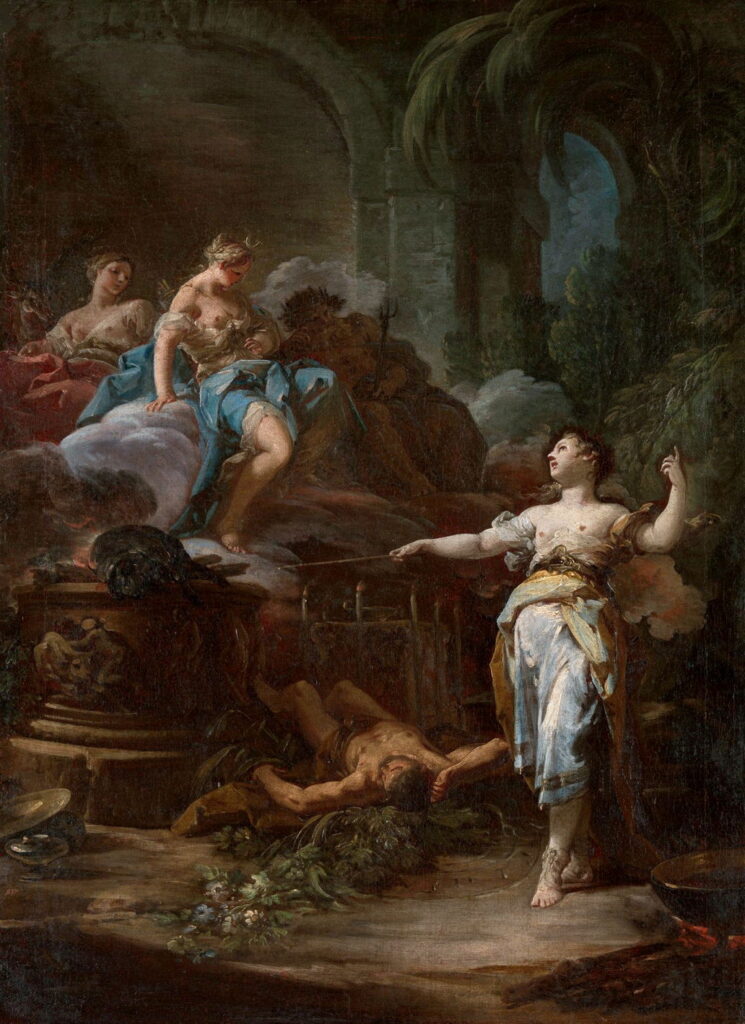Reading visual art: 130 Wand

As every reader of Harry Potter novels knows, those who work magic normally do so with the aid of their wand, a short stick similar to the baton used to control an orchestra by its conductor. Historically, they overlap with staffs, which are generally longer and include those carried by the classical Mediterranean gods, such as Hermes’ caduceus. Shorter wands were popularised during the Middle Ages, and by the nineteenth century had become a symbol of magic and the occult.
In narrative paintings, wands are most strongly associated with the two great sorceresses of classical myth, Circe and Medea.
John William Waterhouse (1849–1917), Circe Offering the Cup to Odysseus (1891), oil on canvas, 149 x 92 cm, Gallery Oldham, Manchester, England. Wikimedia Commons.
John William Waterhouse’s Circe Offering the Cup to Odysseus from 1891 shows Circe sitting on her throne, holding up a krater for Odysseus to drink, with her wand in the other hand. Seen in the large circular mirror behind the sorceress is Odysseus, preparing to draw his sword to defend himself from being turned into a pig like the rest of his crew.
Briton Rivière (1840-1920), Circe and her Swine (before 1896), further details not known. Wikimedia Commons.
Briton Rivière’s painting of Circe and her Swine unusually casts Circe as a magic swineherd, her wand resting behind her.
Paulus Bor (c 1601–1669), The Disillusioned Medea (The Enchantress) (c 1640), oil on canvas, 155.6 x 112.4 cm, The Metropolitan Museum of Art, New York, NY. Wikimedia Commons.
Paulus Bor’s The Disillusioned Medea (The Enchantress) from about 1640 shows her sitting, her face flushed, resting her head on the heel of her right hand. In her left, she holds a wand made from bamboo or rattan. The wand appears poised, ready for use as soon as she has worked out what to do next. Behind her is a small altar, and the statue at the left is Diana.
Bartolomeo Guidobono (1654–1709), Medea Rejuvenates Aeson (c 1700), oil on canvas, 173 x 212 cm, Private collection. Wikimedia Commons.
Bartolomeo Guidobono’s Medea Rejuvenates Aeson from about 1700 shows Medea dressed in an unkempt and wild manner, accompanied by two men. The near-lifeless and pale body of Aeson rests behind her, but a younger man, possibly the rejuvenated Aeson, is materialising under a table. There is a panoply of symbols associated with magic, including a snake and toad, large tomes of spells on top of which is a lizard, an open fire on a small stand, and Medea is touching a deer with the wand in her right hand.
Corrado Giaquinto (1703–1765), Medea Rejuvenating Aeson (1760), oil on canvas, 73.7 x 54.6 cm, Metropolitan Museum of Art, New York, NY. Wikimedia Commons.
Corrado Giaquinto’s Medea Rejuvenating Aeson from 1760 is set outdoors by the arches of a large stone structure, where three gods watch Medea work her spells. At the front of the trio is Diana, wearing a crescent moon as a diadem. To the right is Neptune with his spiked crown and trident, and to the left is (probably) Hecate. Medea stands in a dramatic pose as if on stage, in the midst of casting a spell, her wand held over the inert body of Aeson, which is resting on a bed of flowers and leaves.
Joseph Mallord William Turner (1775–1851), Vision of Medea (1828), oil on canvas, 173.7 x 248.9 cm, The Tate Gallery (Accepted by the nation as part of the Turner Bequest 1856), London. Image © and courtesy of The Tate Gallery, http://www.tate.org.uk/art/artworks/turner-vision-of-medea-n00513
In the middle of JMW Turner’s Vision of Medea (1828), Medea stands making an incantation to force Jason to return to her, a long wand thrust high in her right hand. In the foreground are the materials she’s using to cast her spell: flowers, snakes, and other supplies of a sorceress. Seated by her are the Fates. In the upper right, Medea is shown again in a flash-forward to her fleeing Corinth in a chariot drawn by dragons, the bodies of her children thrown down after their deaths.
Nicolas Poussin (1594–1665), The Companions of Rinaldo (c 1633-4), oil on canvas, 119 x 101 cm, The Metropolitan Museum of Art, New York, NY. Wikimedia Commons.
Wands also appear in some depictions of later literary narratives, including Torquato Tasso’s epic Jerusalem Delivered, a favourite source for Nicolas Poussin’s paintings. When Charles and Ubaldo are dispatched to rescue Rinaldo from Armida’s garden, a wizard gives Ubaldo a golden wand to use to combat Armida’s sorcery. The first obstacle they encounter is a fearsome dragon blocking their passage up the mountain to reach the garden. Charles draws his sword ready to slay the dragon, but Ubaldo waves his golden wand to drive it away, as shown in Poussin’s Companions of Rinaldo (c 1633-4).
William Henry Margetson (1861-1940), ‘She was known to have studied magic while he was being brought up in the nunnery (1914), illustration for ‘Legends of King Arthur and His Knights’, James Knowles, further details not known. Wikimedia Commons.
King Arthur’s sister (or half-sister) Morgan le Fay had been brought up in a nunnery, where it was rumoured she had studied and practised magic. William Henry Margetson’s illustration from 1914 is based on text derived from Malory’s retelling: ‘She was known to have studied magic while she was being brought up in the nunnery’. Here she’s an Arthurian Circe, standing with her wand above a temple tripod, albeit with very short legs.
John William Waterhouse (1849–1917), The Magic Circle (1886), oil on canvas, 182.9 x 127 cm, The Tate Gallery (Presented by the Trustees of the Chantrey Bequest 1886), London. Photographic Rights © Tate 2018, CC-BY-NC-ND 3.0 (Unported), https://www.tate.org.uk/art/artworks/waterhouse-the-magic-circle-n01572
In John William Waterhouse’s Magic Circle from 1886, a barefoot sorceress draws a blazing magic circle in the dust around her with her long wand, as smoke and steam rises vertically from a more substantial tripod used to heat and brew her potion. In her left hand she holds a golden sickle, used to harvest magical herbs.
Elizabeth Eleanor Siddal Rossetti (1829–1862), Clerk Saunders (1857), watercolour, bodycolour, coloured chalks, on paper, laid on a stretcher, 28.4 x 18.1 cm, Fitzwilliam Museum, Cambridge, England. Wikimedia Commons.
In 1802, Sir Walter Scott had published an anthology of ballads titled Minstrelsy of the Scottish Border, among which was this story of Clerk Saunders, painted here in watercolour by Elizabeth Eleanor (Lizzie) Siddal in 1857, when she was attending the Sheffield School of Art, and before she married Dante Gabriel Rossetti. It shows the heroine May Margaret kneeling on her bed and raising a wand to her lips. As she does this, the ghost of her murdered lover Clerk Saunders walks through the wall, and asks her to renew her vows.
Finally, wands can be seen in imagined scenes of witchcraft.
Domenicus van Wijnen (1661–1698), The Witches’ Sabbath by Moonlight (date not known), oil on canvas, 73 x 57.5 cm, location not known. Wikimedia Commons.
Later in the seventeenth century, Domenicus van Wijnen explored this theme in The Witches’ Sabbath by Moonlight, set in a moonlit Italian landscape. This combines many of the now-classical symbols associated with ‘the dark arts’, and is taking place at an outdoor altar set up at the foot of the gallows, on which a dead body hangs. Two women are shown as witches: an older one riding a horned goat facing backwards, who is leaping over a very large smoking cauldron, and a younger woman at the left, who has a wand in her left hand.




